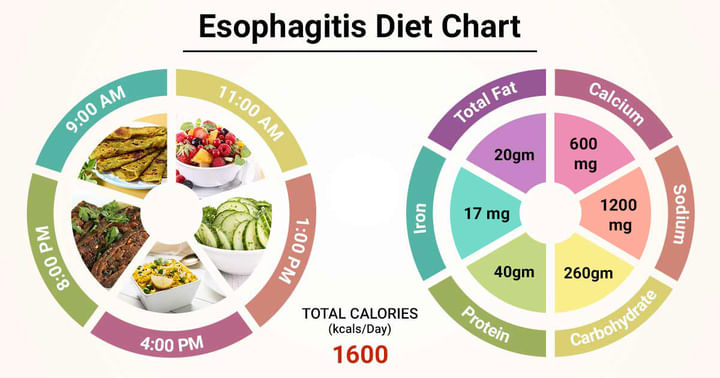Diet Chart For esophagitis
Last Updated: Jan 20, 2025
About
Esophagitis diet plays a crucial role in the treatment of esophagitis. Esophagitis is the inflammation of the esophagus. It may lead to damage to tissues to the esophagus, which is a muscular tube that carries food and liquids from the mouth to stomach. Esophagitis can make it difficult to swallow food. Esophagitis can be caused by infection, irritation of the esophagus, or inflammation of the inner lining of the esophagus. There are many types of esophagitis- reflux esophagitis, infectious esophagitis, drug-induced esophagitis, eosinophilic esophagitis, and lymphocytic esophagitis. Reflux esophagitis, one of the most common types of esophagitis, occurs when acid from the stomach comes up to the esophagus and causes inflammation of the esophagus. Certain foods can trigger acid reflux including chocolate, peppermint, fried or fatty foods, and alcoholic beverages. Eosinophilic esophagitis may be due to an allergic reaction to a food.
Thus, avoiding food that causes esophagitis reduces its symptoms. It must be ensured that esophagitis diet does not corrode the esophagus more. The food that triggers eosinophilic esophagitis and reflux esophagitis must be avoided. Esophagitis diet includes soft vegetables and vegetables, dairy products (provided you are not allergic to milk), cereals and crackers. While eating, chewing food completely, having small bites and swallowing slowly will also help with the pain.
Diet Chart
| Sunday | |
| Breakfast (8:00-8:30AM) | Methi Parata 2+ 1 tbs green chutney( Avoid mint leaves) |
| Mid-Meal (11:00-11:30AM) | 1 Portion fruit(Avoid Citrus fruits) |
| Lunch (2:00-2:30PM) | 1 cup rice+ chicken curry( 150 gm chicken+ 1 cup cucumber salad. ( Avoid onoin and tomato for the preparation of masala and avoid more spices) |
| Evening (4:00-4:30PM) | Brown rice flakes poha 1 cup. |
| Dinner (8:00-8:30PM) | Wheat dosa 3 + 1/2 cup Bitter guard subji.( Avoid onoin and tomato for the preparation of masala and avoid more spices) |
| Monday | |
| Breakfast (8:00-8:30AM) | Vegetable Oats Upma 1 cup+ 1/2 cup low fat milk. |
| Mid-Meal (11:00-11:30AM) | plane low fat Yoghurt with raw vegetables / grilled vegetables -1 cup( Avoid onion and tomato) |
| Lunch (2:00-2:30PM) | 1/2 cup rice + 2 medium chappati+1/2 cup Kidney beans curry+ Snake guard subji 1/2 cup. ( Avoid onoin and tomato for the preparation of masala and avoid more spices) |
| Evening (4:00-4:30PM) | 1 cup boilled channa. |
| Dinner (8:00-8:30PM) | 2 Roti/ chapati+ 1/2 cup mix veg curry.( Avoid onoin and tomato for the preparation of masala and avoid more spices) |
| Tuesday | |
| Breakfast (8:00-8:30AM) | Mix veg Poha 1 cup+ 1/2 cup low fat milk. |
| Mid-Meal (11:00-11:30AM) | 1 Portion fruit(Avoid Citrus fruits) |
| Lunch (2:00-2:30PM) | 3 Chappati+ 1/2 cup cluster beans subji+ Fish curry(100g fish) 1/2 cup. ( Avoid onoin and tomato for the preparation of masala and avoid more spices) |
| Evening (4:00-4:30PM) | 3 biscuits ( Nutrichoice or Digestiva or Oatmeal.) |
| Dinner (8:00-8:30PM) | 2 Roti / chappathi+Ridge guard subji 1/2 cup.( Avoid onoin and tomato for the preparation of masala and avoid more spices) |
| Wednesday | |
| Breakfast (8:00-8:30AM) | Utappam 2+ 1 tbs green chutney.( Avoid mint leaves) |
| Mid-Meal (11:00-11:30AM) | 1 cup boilled channa |
| Lunch (2:00-2:30PM) | 1 cup rice+ Soya chunk curry1/2 cup+ Ladies finger subji 1/2 cup+ small cup low fat curd. ( Avoid onoin and tomato for the preparation of masala and avoid more spices) |
| Evening (4:00-4:30PM) | 1 Portion fruit(Avoid Citrus fruits) |
| Dinner (8:00-8:30PM) | Broken wheat upma 1 cup+ 1/2 cup green beans subji |
| Thursday | |
| Breakfast (8:00-8:30AM) | 4 Idli + Sambar 1/2 cup/ 1 table spoon Green chutney.( Avoid mint leaves),( Avoid onoin and tomato for the preparation of masala and avoid more spices) |
| Mid-Meal (11:00-11:30AM) | green gram sprouts 1 cup |
| Lunch (2:00-2:30PM) | 3 Roti+1/2 cup salad + Fish curry ( 100 gm fish)+ 1/2 cup cabbage subji. ( Avoid onoin and tomato for the preparation of masala and avoid more spices) |
| Evening (4:00-4:30PM) | 1 Portion fruit(Avoid Citrus fruits) |
| Dinner (8:00-8:30PM) | 2 Roti / chappati.+Potato subji 1/2 cup.( Avoid onoin and tomato for the preparation of masala and avoid more spices) |
| Friday | |
| Breakfast (8:00-8:30AM) | 2 Slice brown bread.+1 slice low fat cheese+1Boiled egg+ 1/2 cup low fat milk. |
| Mid-Meal (11:00-11:30AM) | 1 Portion fruit(Avoid Citrus fruits) |
| Lunch (2:00-2:30PM) | Veg pulav rice 1 cup+ 1/2 cup Soya Chunk curry+ 1/2 cup Low fat curd. ( Avoid onoin and tomato for the preparation of masala and avoid more spices) |
| Evening (4:00-4:30PM) | 3 wheat rusk. |
| Dinner (8:00-8:30PM) | 2 roti/ Chapathi+ Ladies finger subji 1/2 cup.( Avoid onoin and tomato for the preparation of masala and avoid more spices) |
| Saturday | |
| Breakfast (8:00-8:30AM) | Chappati 3 + 1/2 cup Potato green peas curry.( Avoid onoin and tomato for the preparation of masala and avoid more spices) |
| Mid-Meal (11:00-11:30AM) | 1/2 cup boilled black channa |
| Lunch (2:00-2:30PM) | 1 cup rice+ 1/2 cup Dhal+ Palak subji 1/2 cup+ 1/2 cup low fat curd. |
| Evening (4:00-4:30PM) | 1 Portion fruit(Avoid Citrus fruits) |
| Dinner (8:00-8:30PM) | Broken wheat upma 1 cup+ 1/2 cup green beans subji |
Food Items To Limit
High-fat foods: Fried and fatty foods can cause the LES to relax, allowing more stomach acid to back up into the esophagus. These foods also delay stomach emptying. Eating high-fat foods puts you at greater risk for reflux symptoms, so reducing your total daily fat intake can help.
The following foods have a high-fat content. Avoid these or eat them sparingly:
- french fries and onion rings
- full-fat dairy products, such as butter, whole milk, regular cheese, and sour cream
- fatty or fried cuts of beef, pork, or lamb
- bacon fat, ham fat, and lard
- desserts or snacks such as ice cream and potato chips
- cream sauces, gravies, and creamy salad dressings
Fruits and vegetables are important in a healthy diet. But certain fruits can cause or worsen GERD symptoms, especially highly acidic fruits. If you have frequent acid reflux, you should reduce or eliminate your intake of the following foods:
- oranges
- grapefruit
- lemons
- limes
- pineapple
- tomatoes
- tomato sauce or foods that use it, such as pizza and chili salsa
Chocolate: Chocolate contains an ingredient called methylxanthine. It has been shown to relax the smooth muscle in the LES and increase reflux.
Garlic, onions, and spicy foods: Spicy and tangy foods, such as onions and garlic, trigger heartburn symptoms in many people. These foods won’t trigger reflux in everyone. But if you eat a lot of onions or garlic, make sure to track your meals carefully in your diary. Some of these foods, along with spicy foods, may bother you more than other foods do.
Caffeine: People with acid reflux may notice their symptoms acting up after their morning coffee. This is because caffeine is a known trigger of acid reflux.
Mint: Mint and products with mint flavoring, like chewing gum and breath mints, can also trigger acid reflux symptoms.
Do's And Dont's
Do's :
- Use good pill-taking habits. Always take a pill with plenty of water. Don't lie down for at least 30 minutes after taking a pill.
- Lose weight. Talk to your doctor about an appropriate diet and exercise routine to help you lose weight and maintain a healthy weight.
- Raise the head of your bed. Place wooden blocks under your bed to elevate your head. Aim for an elevation of 6 to 8 inches (15 to 20 centimeters). Raising your head by using only pillows isn't effective.
- Allow for at least 3 hours between meals and lying down
- Eat small frequent meals (5-6 a day)
Don'ts:
- Avoid foods that may increase reflux. Avoid eating excessive amounts of foods that you know worsen your symptoms of gastroesophageal reflux. These may include alcohol, caffeine, chocolate and mint-flavored foods.
- If you smoke, quit. Talk to your doctor if you need help ending a smoking habit.
- Avoid stooping or bending, especially soon after eating.
- Avoid lying down after eating. Wait at least three hours after eating to lie down or go to bed.
- Drink caffeine, alcohol; eat chocolates, peppermints, peanut butter, tomatoes/acidic fruits (orange, grapefruit, lemon), greasy/spicy food
- Don't wear tight clothing/belts
Food Items You Can Easily Consume
- Vegetables:Vegetables are naturally low in fat and sugar, and they help reduce stomach acid. Good options include green beans, broccoli, asparagus, cauliflower, leafy greens, potatoes, and cucumbers.
- Ginger: Ginger has natural anti-inflammatory properties, and it’s a natural treatment for heartburn and other gastrointestinal problems. You can add grated or sliced ginger root to recipes or smoothies or drink ginger tea to ease symptoms.
- Oatmeal: Oatmeal is a breakfast favorite, a whole grain, and an excellent source of fiber. Oatmeal can absorb acid in the stomach and reduce symptoms of reflux. Other fiber options include whole-grain breads and whole-grain rice.
- Noncitrus fruits: Noncitrus fruits, including melons, bananas, apples, and pears, are less likely to trigger reflux symptoms than acidic fruits.
- Lean meats: Lean meats, such as chicken, turkey, fish, and seafood, are low fat and reduce symptoms of acid reflux. Try them grilled, broiled, baked, or poached.
- Egg whites: Egg whites are a good option. Stay away from egg yolks, though, which are high in fat and may trigger reflux symptoms.
- Healthy fats: Sources of healthy fats include avocados, walnuts, flaxseed, olive oil, sesame oil, and sunflower oil. Reduce your intake of saturated fats and trans fats and replace them with these healthier unsaturated fats.
References
- Kagalwalla AF, Sentongo TA, Ritz S, Hess T, Nelson SP, Emerick KM, Melin–Aldana H, Li BU. Effect of six-food elimination diet on clinical and histologic outcomes in eosinophilic esophagitis. Clinical gastroenterology and hepatology. 2006 Sep 1;4(9):1097-102. [Cited 02 July 2019]. Available from:
- Straumann A. Treatment of eosinophilic esophagitis: diet, drugs, or dilation?. Gastroenterology. 2012 Jun 1;142(7):1409-11. [Cited 02 July 2019]. Available from:
- Lucendo AJ, Arias A. Treatment of adult eosinophilic esophagitis with diet. Digestive Diseases. 2014;32(1-2):120-5. [Cited 02 July 2019]. Available from:
Table of content
Find Dietitian/Nutritionist near me
Ask a free question
Get FREE multiple opinions from Doctors



